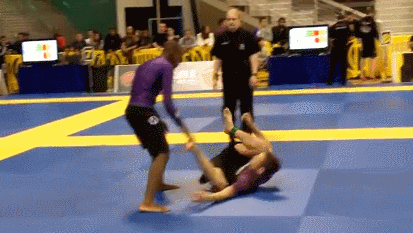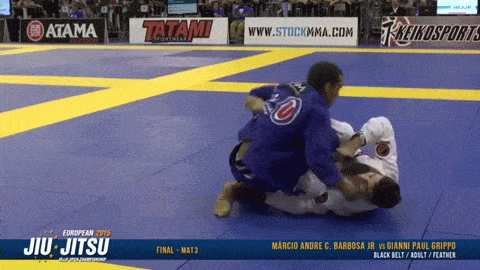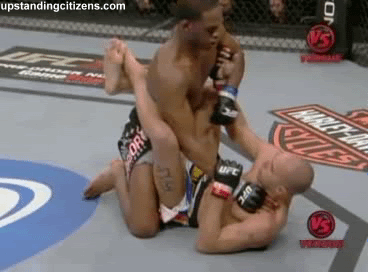
So, let’s get back to a niche topic I haven’t covered in a while. How many of you have been to a modern-day Jiu-Jitsu tournament and saw something like this? What the hell is even happening here?
Now, I didn’t grow up in the golden glory days of the art where the smaller, pajama-clad man easily strangled someone double his size. I won’t pretend to be part of the old-school system.
But truth be told, Brazilian Jiu-Jitsu lost its edge. A long fucking time ago.
Go ahead, fight me. Argue, cry, bitch, moan, and complain. But deep down in your heart of hearts, you know I have a point.
Natural Progression In Play?
Remember the very first UFC event in ‘93? Royce Gracie was a scrawny little Brazilian man who tore through the competition like a hot knife through butter. He was the star of the show, and he made the world outside of Rio de Janeiro take notice.
From then on, the rest of humanity wanted to know the secret. How could a seemingly gawky individual make his muscular, strapping opponent say ‘Uncle’ inside one minute? What’s the secret sauce, if there even is one?
At the time, no one knew about the sorcery that was Brazilian Jiu-Jitsu. As far as the average fight nut of the early 90s was concerned, it was knock someone out or GTFO.
Fast forward to this era of modern-day Jiu-Jitsu. You’ll see a lot of butt-scooting and allowing your opponent to smother you to the mat. While it works well for sport, it can be a huge eyesore.
You can chalk it up to changing times, but I’m not alone in my assessment.
The Question of Effectiveness
If we were to turn to a list of trusted resources about everything submission grappling, John Danaher would likely be somewhere at the top.
To call him a ‘walking encyclopedia’ would be an understatement. He’s one of the sharpest living minds out there today. His philosophy and approach are both menacing and artfully perplexing.
Instead of me throwing out more flowery words for the man, go look him up.
John and I share similar views about the effectiveness of modern-day Jiu-jitsu as a fighting art. Gone are the days when it was a significant facet of an athlete’s skill set.
Modern-Day Jiu-Jitsu is Dead…?
To those of you who’ve been fans of the sport over the last decade, name three BJJ-based fighters among today’s elite mixed martial artists. Ones who aren’t called Charles Oliveira or Mackenzie Dern.
Nada. Zilch. It’s no longer a fighter’s primary weapon. Hell, it’s not even an immediate backup.
Danaher notices the same trend in present-day MMA.
“What you’re seeing among Jiu-Jitsu athletes now, who go into mixed martial arts, is they have to turn to other arts,” he told Joe Rogan. “They have to learn wrestling, they have to learn these other… and there’s nothing wrong with that.
“But the truth is, Jiu-Jitsu has become a smaller and smaller component of mixed martial arts. Rather than what it was when it first started, which is a dominant force in mixed martial arts.”
Here’s a spicy truth bomb.
“Now, for most of the athletes, Jiu-jitsu is something you learn to stay out of some pesky submission holds. Most of them are centered around kickboxing skills and wrestling.”
The guy sounds like he reads off a movie script, but I’ve seen him up close. He’s as eccentric as advertised, the type who’d go online on an old school, fat monitor desktop computer in the dark coaches’ lounge in the blue basement.
But I digress.
Modern-day jiu-jitsu is officially a spectator sport, boxed in a frame of rulesets to cater to a worldwide audience. And with that, the art itself lost some of its fangs.
Danaher brought up an excellent point. Today’s athletes train to be comfortable being on their backs when taken down or placed in a compromising position.

They hold zero worries about concussive strikes to the face that gradually turn it into mush. Tournaments don’t permit that.
Now, bring that same approach inside a mixed martial arts cage.

See where the problem is?
Has Modern-Day Jiu-Jitsu Lost Its Edge?
Despite the knowledge I’ve gained over the last nine years of training and coaching, I’m no expert to give a response you’d call accurate or reliable, perhaps.
But in applying it to a discipline that’s supposedly the best for a real-world scenario, I’d say hell yes.
Danaher said it best: Modern-day jiu-jitsu may need some growing up to do.
“Jiu-jitsu has to do something about the crisis that’s starting to emerge around takedowns and the ability to impose top position.”
You can’t blame today’s generation of practitioners. They’re simply a byproduct of evolution.
But if you ask me, the classic “takedown-secure dominant top position-submit” formula will ALWAYS work. It’s timeless and battle-tested. It works against opponents your size or someone bigger.
Most importantly, it will get you places in MMA and could save your life in the street. But that’s a topic for another time.
My advice? Feel free to practice the fancy, Instagrammable shit, sure. But at the end of the day, don’t forget to utilize its potential as a highly functional weapon.
It’s not just about having the sharpest sword in the arsenal. Most importantly, it’s about wielding it effectively.
Modern-day jiu-jitsu isn’t a lost cause… yet. And YOU, the practitioner, can help prevent that from happening.
Cheers, and be well.





2 thoughts on “Is It Just Me or Has Modern-Day Jiu-Jitsu Lost Its Edge?”
Have a look at the full video of the first gif you inserted.
2 seconds after the clip cuts off the bottom guy hits a triangle to win.
Not so stupid now.
https://www.youtube.com/watch?v=xl5YYqVe1cU
Watch it again. The dude in the purple rashie lazily threw the legs away, seemingly attempting to pass. But his hasty efforts put him in the firing line for the choke.
So yes, it’s still mind-numbingly stupid. But hey. You do you.